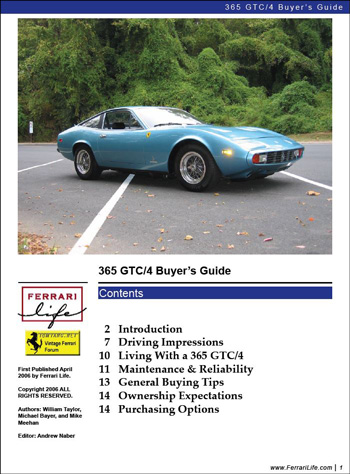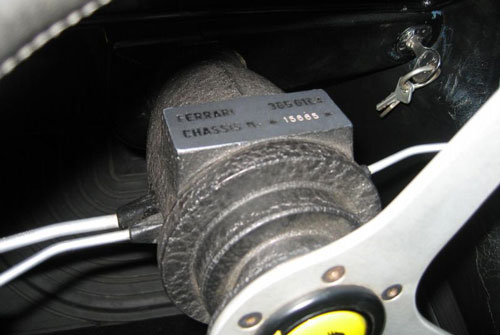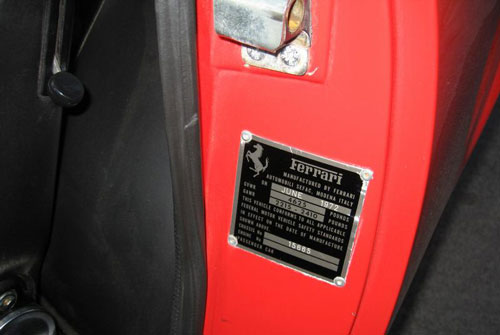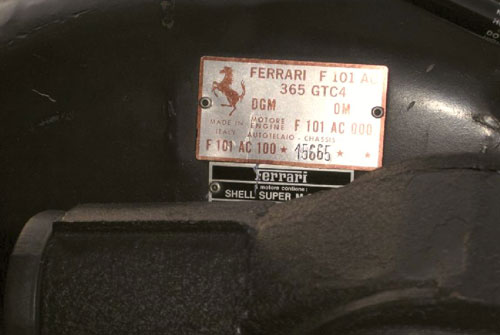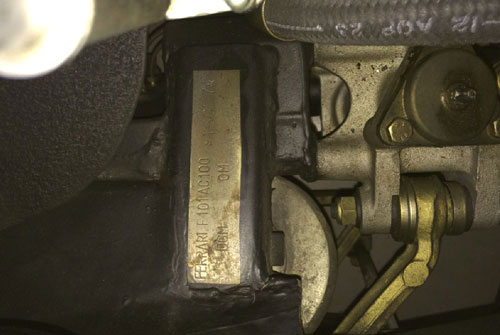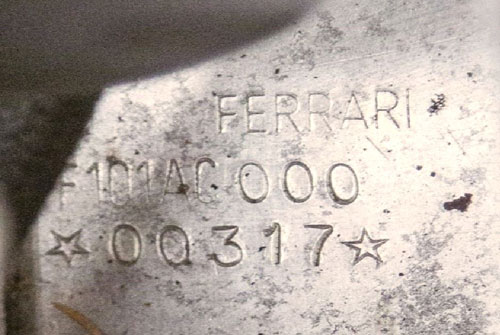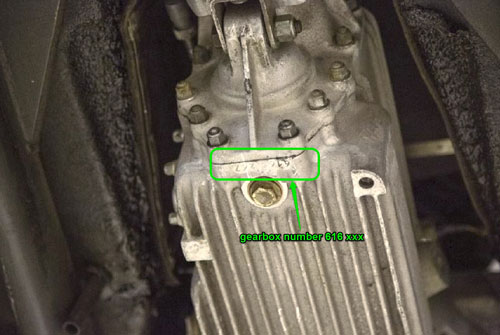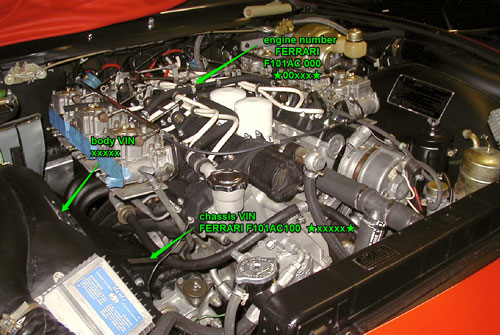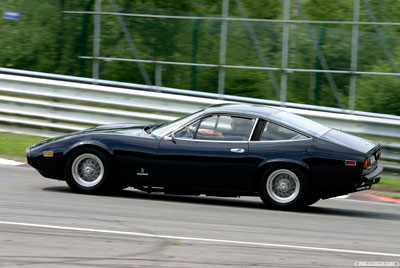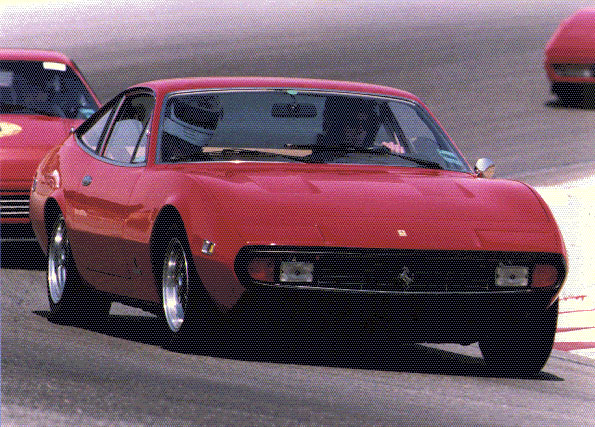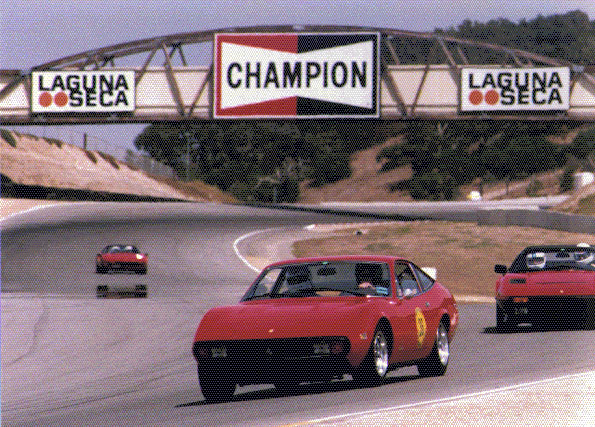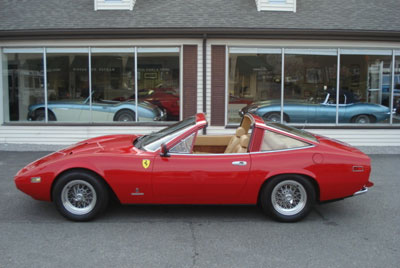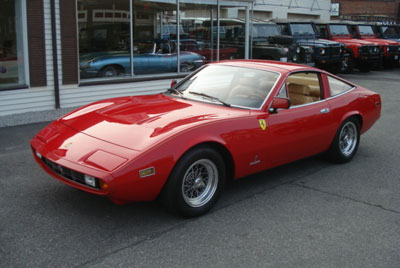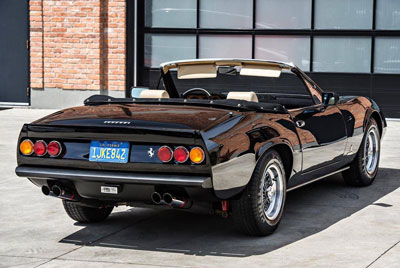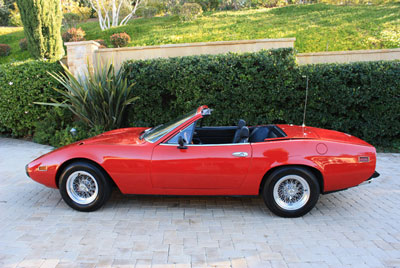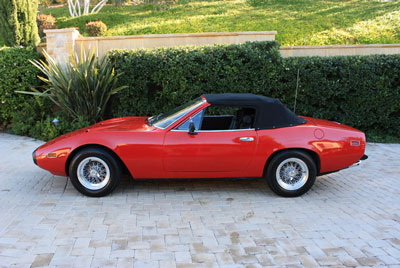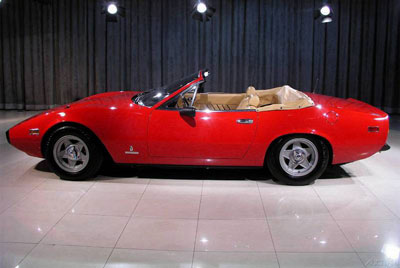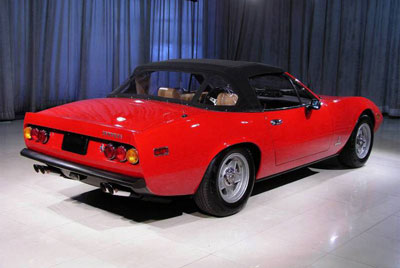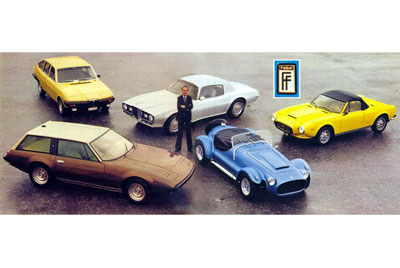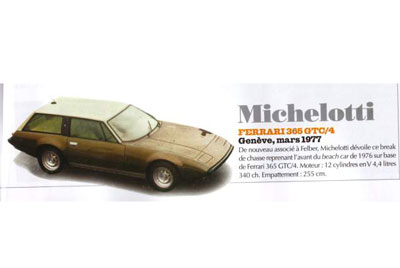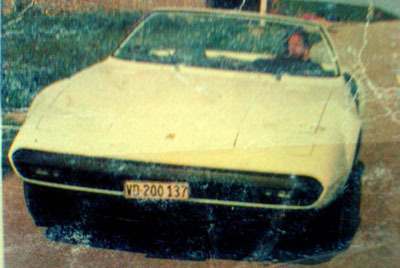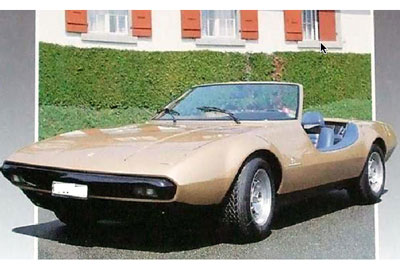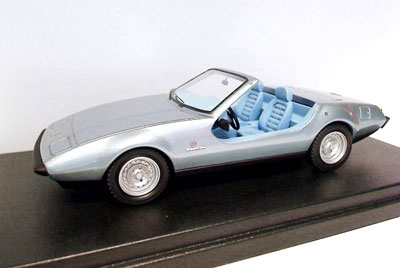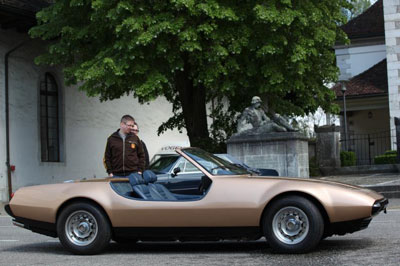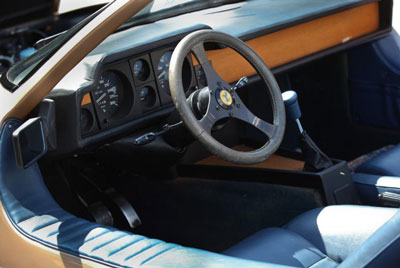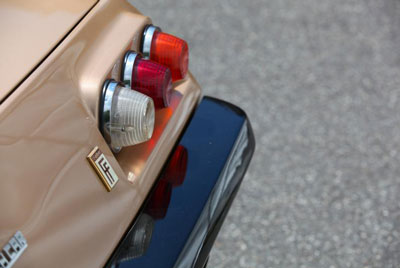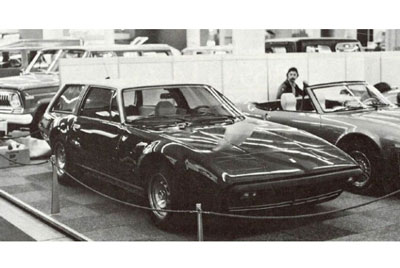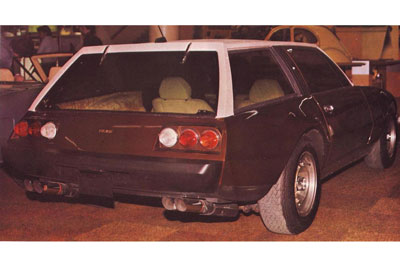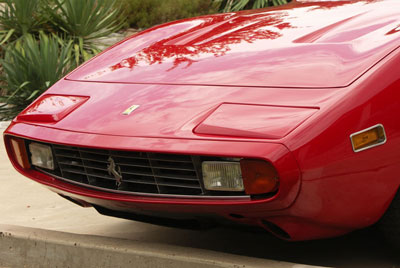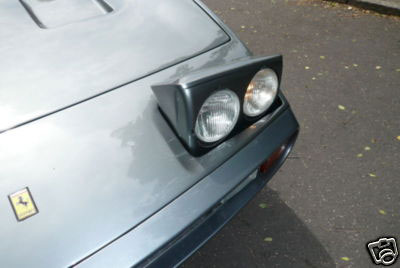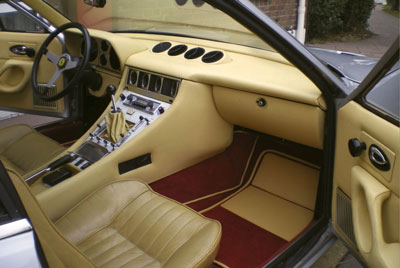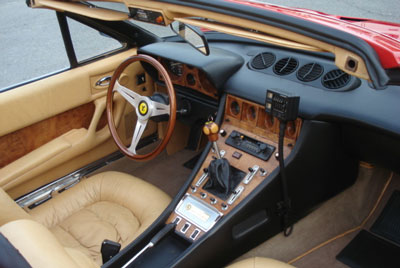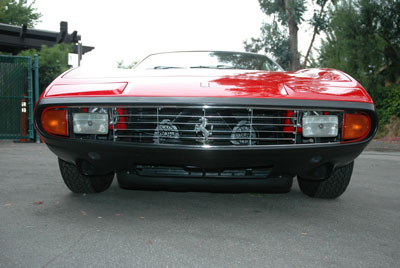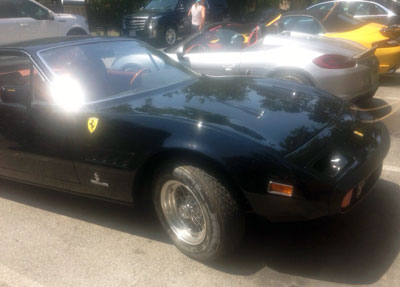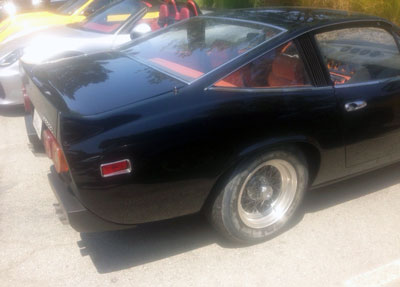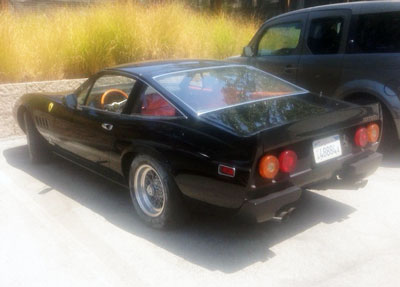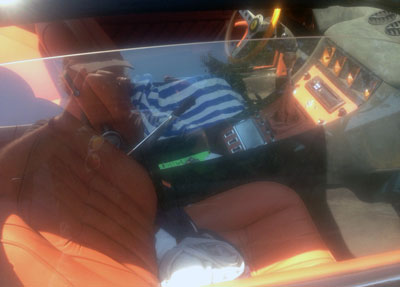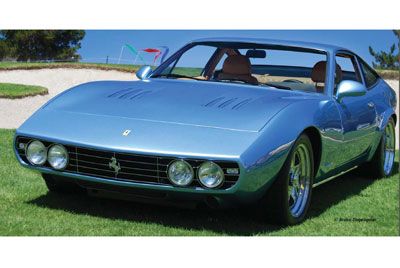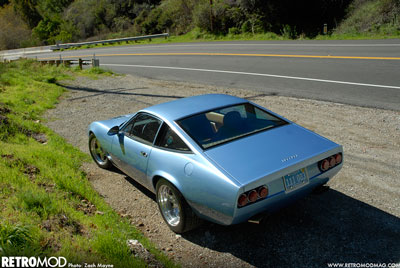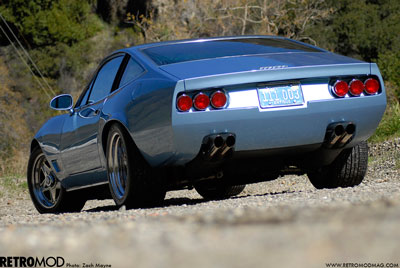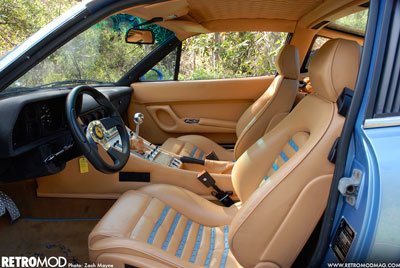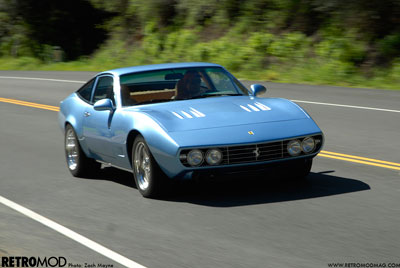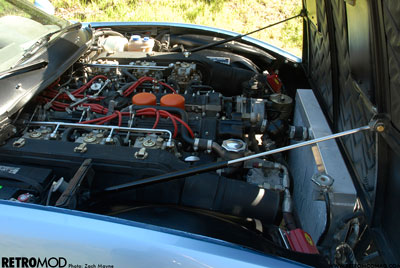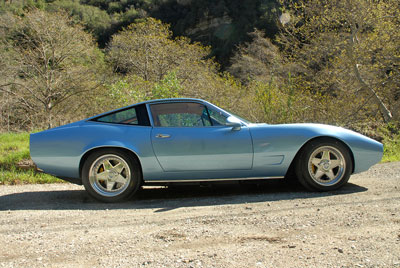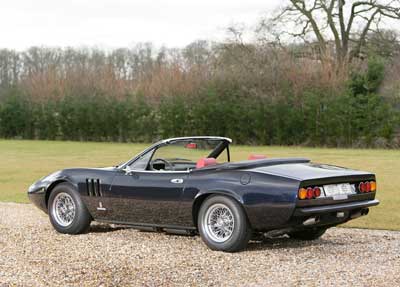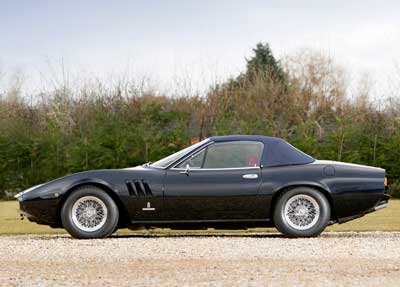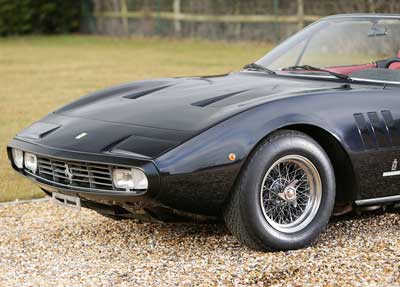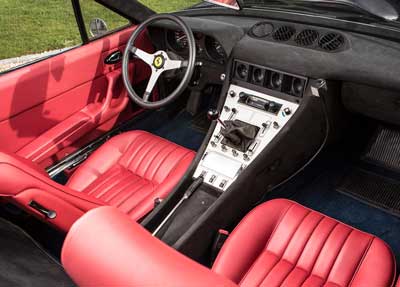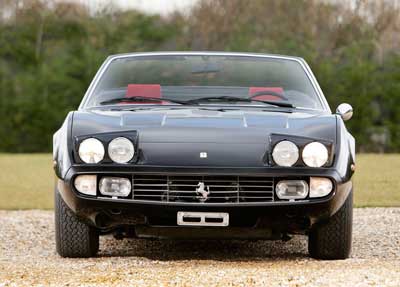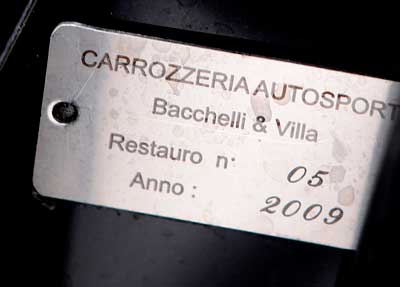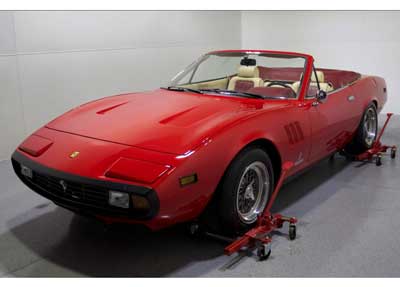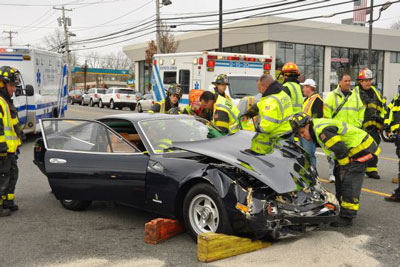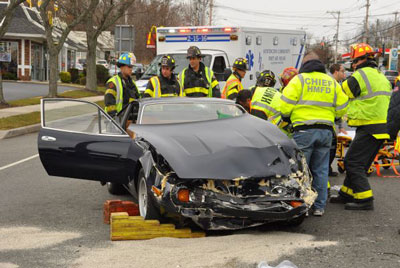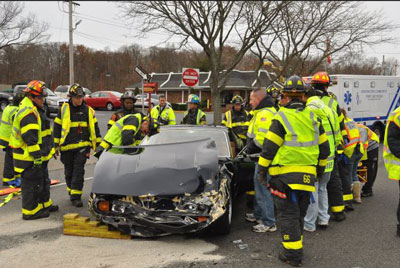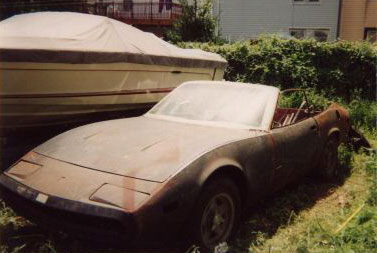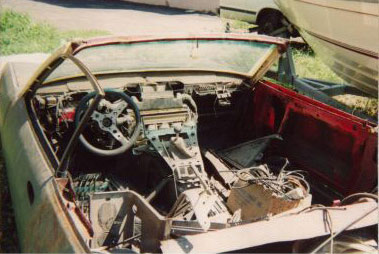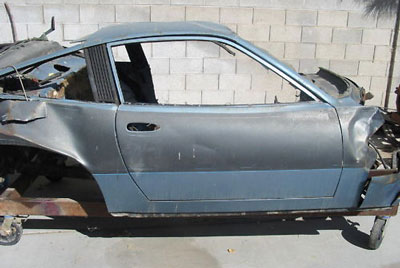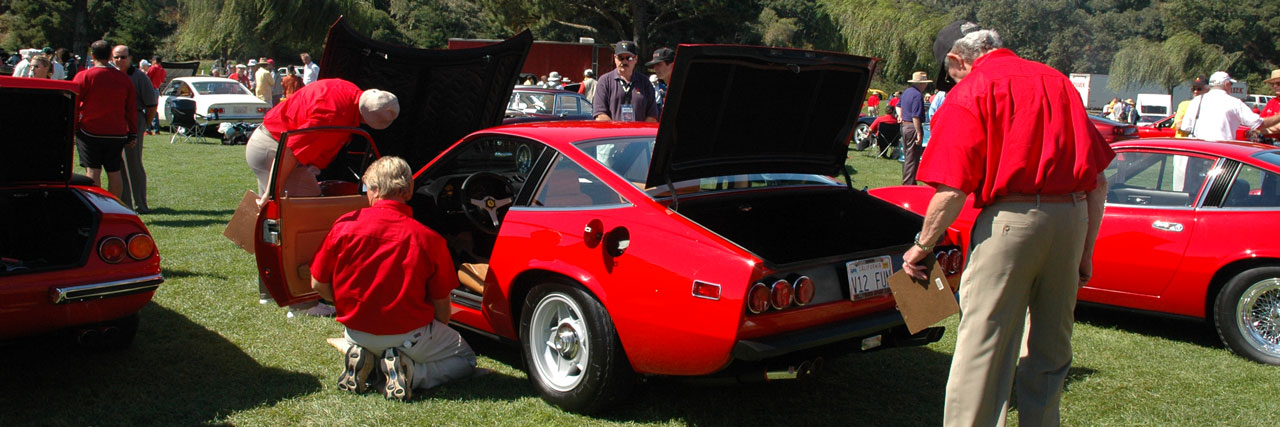
If you are the owner of a 365 GTC/4 then we encourage you to register so that you can get the full benefits of the site, including the ability to post to the forum, view the online registry of cars, and converse with other owners. Registration is limited to 365 GTC/4 owners only.
On the Track
Not all Ferrari are trailer queens and some owners regularly exercise their 365 GTC/4s on the track. Here's a shout out to the members who use their cars.
Common Problems
Every car has some design flaw or other problem area and the 365 GTC/4 is no different. Overall, the cars are remarkably reliable but when a problem arises the owners post to the Forum for answers. Anyone can search the forum to see what the owners are discussing. Here's a select list of issues many owners have encountered.
- Leaky load levelers
- The seals on the Koni load leveling shocks in the rear of the car eventually perish and leak oil. When this happens there are two choices: repair them or replace them with coil over shocks. New load levelers are not available. Repair requires specialized seals, a gasification tool, high pressure nitrogen, and knowledge. Koni now offers rebuilding of the unit but they don't have the correct seal and end up modifying the internals to use a different seal. This fix has been known to fail. Avoid Jeff LeBlond in Arizona -- he welds in bungs for Schrader valves and generally messes things up. Fortunately, a 365 GTC/4 owner in Australia has had the original seals reproduced and has built a tool for recharging the units. But he operates on a good-will basis, not as a business.
- Tailpipe rust
- Because the tailpipes angle upward at the rear, a low spot exists in the back of the muffler box and in the lower bend of the tailpipe where condensation can sit and corrode the units. When this happens there are two choices: buy new tailpipes from ANSA (they are still available) every decade or two or buy an aftermarket stainless steel exhaust. Also, exhaust parts no longer available from ANSA (such as the US center mufflers) can be purchased from Classiche s.r.l. - the company that purchased all of ANSA's old tooling.
- Exhaust smell
- These are old carburated cars so a certain rich smelling exhaust is part of the "charm". That said, the cars need to be properly jetted and tuned for optimal combustion. To avoid smelly clothes in the trunk one must make certain that the trunk lid is properly aligned and has a good rubber seal. Finally, make sure there are no holes in any portion of the exhaust system.
- Rusting exhaust heat shields (US cars)
- Cars built for the USA market had crudely built steel heat shielding around the headers. Inside this shielding was some thermo wrap batting that gathered moisture and accelerated rusting of the metal outside. The fix is to cut off the old metal and coat the headers with a modern ceramic coating.
- Headlight motors
- The pop-up headlight system is a complex pre-digital system consisting of two motors, linkage, switches, and a number of mechanical relays. Generally speaking, it is quite reliable but the relays can fail and the motors can get their cams out of sync if messed with. Fortunately, we have a headlight troubleshooting guide and, if all else fails, the motors have knobs on top which can be manually rotated in case of emergency.
- Brake hose deterioration
- The rubber brake hoses swell and deteriorate from the inside, resulting in caliper lock-up. The fix is simple: replace your brake hoses (they are available).
- US Thermo valve flaps
- Another problem unique to US models. The US air cleaner has a flap in the snorkel that is controlled by oil pressure/temperature. They never worked properly and everyone quickly learned to plug the oil lines and remove the flap from inside the air cleaner.
- Rear window rust
- As mentioned, the cars don't have a lot of rust issues but water running off the roof, down the rear window tends to settle at the bottom of the widow and can rust through. Look for water damage on the mouse hair trim below the window. Fix like any other rust.
- Front brake duct valance rust
- There is a pocket below the brake ducts and above the valance where leaves and junk can get stuck and collect moisture. Clean out, fix if rusted.
- Hood scoop cracks
- The aluminum hood is generally well braced and strong but there is a slight weak spot in the front corners of the hood scoops where the metal and/or paint can crack. Fix as normal.
- Crazed black cowl paint
- For some reason, the matte black paint on the cowl below the wipers tends to craze and can be very difficult to eradicate. Strip to bare metal and respray.
- Hot starters
- If there is any weakness in the battery, cables, solenoid, ignition switch, or starter motor then they will make themselves known when trying to start a hot car. The starter soaks a lot of heat from the headers. If everything is in proper working order, including the curves heat shield above the starter motor, then there shouldn't be any problems. There are also smaller aftermarket high torque starters that can be fitted. Make sure any starter is properly shimmed to correctly engage the teeth on the flywheel.
- Power steering overheat on track
- Overall the cars do quite well on the track but one issue is power steering fluid frothing/overheating and coming out the hood scoop. This is due to persistent high RPMs on the power steering pump. Proper levels, high quality fluid, and some cool down laps should manage the problem.
- Accessory belt clicking
- After sitting for a long time, the accessory belts can gain a "memory" of the pulley curves. When started cold, these "kinks" in the Kevlar-reinforced belts can make a snapping, or clicking sound that makes one fear bigger problems. The fix: wait for the belts to warm up. And drive the car more often.
- Hood pad sag
- The insulation material on the underside of the hood is held on via adhesive and some perimeter slots. Over time, heat and oils cause the adhesive to fail, usually near the scoop openings where there is no additional support. Because adhesive doesn't stick to oily materials, it is usually impossible to get the old pad to adhere again. Fortunately, replacement hood pad kits are still available. Note that the pads on the 365 GTC/4 are perforated black, not the silver used on Daytonas.
- Carb tuning
- This isn't really an issue. Once set, the carbs are remarkably trouble free. However, getting them set in the first place takes some skill and tools. The linkage needs to be exactly correct, the jetting needs to be properly sized, and the idle mixture needs to be set using a multi-tube hydrometer.
- Blinker cancel issues
- Some onwers are recently experiencing blinkers that don't automatically cancel after the steering is turned and sthen straightened. There is a plastic cam in the column that wears. Fortunately, Unobtainium Supply can repair them.
- Oil leaks
- British cars only stop leaking when they run out of oil. The 365 GTC/4 isn't that bad but there are some common areas in and around the timing chain cover than are notoriously difficult to get properly sealed. Either replace the gaskets or live with the leak.
- Timing chain tensioners
- The timing chain on the 365 GTC/4 engine is quite long and therefore can rattle if stretched. The original tensioner design (pre 15181 & 15289) was not as beefy as the later units.
- Difficult removing air filters
- Yep. They are a pain to remove. Getting the side covers off is easy - just 6 clips. But there isn't enough room between the carb trumpets and the brake booster to get the filter element out. Worse, there are 3 nuts around each carb throat that hold the air cleaner box to the carb. Getting them all off is a time consuming and fiddly job. Be patient.
- Difficult getting to valve adjust
- With side draft carbs, to get to the valves you must first remove all the carbs. Getting the air cleaner off is the hardest part but it's still a lot more difficult than with a Daytona.
- Cam wear
- Gary Bobileff once wrote an article for Sempre Ferrari claiming that Ferrari had a flaw in their 4-cam camshaft hardening process prior to the 365 BB. Be sure to inspect the cams and shims during every valve adjustment. If necessary, the cams can be repaired or replaced.
- Cracked speaker grills
- The grills are plastic and tend to get kicked. Fortunately, someone has made metal versions.
- Broken seat vent rings
- The outer vent rings are plastic and break if the seat leather is replaced. Fortunately, someone has made reproductions.
- Broken sun visor clips
- The clips are plastic and can break. Fortunately, someone has made reproductions.
- Broken air vent retainers
- The four round air vents in the dash are held in place by a wire clip attached to the plastic center post. That post can break but the vent can be repaired with some patient drilling and epoxy and a screw.
Targas and Spyders
Many owners want to express their individuality onto their cars. This is not traditionally so popular with Enzo-era V-12 Ferrari because of the potential negative effect on value -- one man's personal touch is often another man's abomination. Even so, the 365 GTC/4 has been the object of a few conversions, including cabriolet (spyder), targa, and even station wagon mods. The first known cabriolet conversion was made by Luigi Chinetti Jr. in 1981 and a second one was completed in early 1984 by Mike Sheehan's European Auto Restoration in Costa Mesa, CA. Claudio Zampolli's Italia Sports Cars of Sherman Oaks, CA converted at least three 365 GTC/4s into cabriolets or targas. The contours of the body practically dictate where the new deck for the cabriolet must be. Some conversions (such as by Claudio Zampolli) use a canvas or vinyl snap-on top boot while others have a more sophisticated fold-up hard tonneau cover. Often the cabriolet conversions are combined with other modifications such as custom upholstery, painted bumpers, woodgrain instruments, and decklid spoilers.
Willy Felber Cars
In cooperation with the Italian design firm Michelotti, the Swiss Willy Felber made two custom cars, both based on the single 365 GTC/4 s/n 16017. In 1976 16017 was rebodied by Felber as the Michelotti-designed "Beach Car" and subsequently shown at the 1976 Geneva Salon. This body was then removed and replaced by Felber with a brown "shooting brake" body with a white roof (not to be confused with the blue "Croisette" body Felber installed on 365 GT4 2+2 s/n 18255). After showing the car with the shooting brake body at Geneva in 1977, Felber reinstalled the Beach Car body. 16017 still exists today in beach car configuration and has been seen at shows and auctions in and around Switzerland with gold paint and blue interior. All records indicate that it has never left the Switzerland area and that the current owner thinks it is worth much more than the market thinks. According to W.H. Felber's Classic Car site:
the "Sheikh of Qatar asked for them to build a beach car. ...the vehicle was to some extent the fun version of a Ferrari. The two-seater car had neither roof nor doors and transferred the concept of the buggies to larger dimensions".
Unfortunately, the Sheikh portion (Sheikh Al Tahani) of this story is almost certainly incorrect. The beach car shown in 1976 was built on spec and not for any Sheikh. Besides, it was rebodied in 1977 into the shooting brake. It is possible that a Sheikh later (circa 1981) commisioned a shooting brake from Felber based on having seen the 1977 show car but 16017 was not that car. The site also claims the basis for the car was a Daytona Spider, which is again incorrect. Beware marketing materials from car customizers.
It is more common for rich Middle Easterners to commission shooting brakes than "beach cars". Unfortunately, the 1977 Felber shooting brake body was destroyed when the car was rebodied back into the beach car. Car and Driver covered a number of Ferrari shooting brake (or "station wagon") conversions in this article.
Other Custom Touches
A much less severe custom touch that is quite popular is painting the front bumper in body color. Inexplicably, a number of owners have covered their console and instruments with wood grain applique. One of the least significant but popular modifications is to paint the lower front valence matte black to match the rear of the car and take some attention away from the duct work under the front bumper.
One example of a successful custom 365 GTC/4 is s/n 14837. Finished in a shade of Azzuro metallic, the car has undergone significant customization in bodywork, interior, and mechanicals. The front of the car has been heavily modified by removing the black front bumper and creating an entirely new nose that eliminates the pop-up headlights in favor of a custom grill with headlight openings and small turn signal indicators. Moving back along the car one finds that the side marker lights have been shaved, 3 polished metal "strakes" have been added to each hood scoop, and side vents have been cut into the front fenders. Custom side mirrors have been added to each door and a tasteful flaring of the front and rear fenders allows for wider wheels and tires. The rear of the car was also substantially modified. The rear bumper was completely removed, the tailpipes shortened and the center panel modified and painted in body color. A small rear kick-up was molded into the trunk lid and rear quarter panels and the body accent lines sharpened.
The interior was changed by adding 550 Maranello seats and removing the rear seats altogether. A rear package shelf was created to fill the rear seat area. This makes the C/4 into a true 2-seat sports car like the Daytona. The console sides were covered in seat leather and custom door panels were created by Prestige Upholstery in Van Nuys, CA. They use parts from a 550 and move the interior door latch onto the armrest. A more modern steering wheel and a larger shift ball add to the enhanced driving experience.
Mechanically, this Ferrari 365 GTC/4 has been specially modified by Carobu Engineering. The modifications include a 5.0 liter C/4-412i hybrid engine, Brembo GT "Big Brake" kit, 17" Razzo Rosso wheels and height adjustable suspension with 300-lb front and 200-lb rear springs. The 17x8-inch front and 17x10-inch rear Razzo Rosso wheels carry 235/50-17 front and 285/40-17 rear tires. Following break-in and tuning, this engine produced maximum power of 410 HP at 6,400 rpm and maximum torque of an amazing 385 lb-ft at 4,500 rpm. In August 2009 Forza Issue 95 featured an article on 14837.
While sporting fewer modifications than 14837, another well done custom 365 GTC/4 is s/n 15869. It is a spyder conversion by Carrozzeria Auto Sport in Bastiglia, near Modena, a company whose experience stretches back to 1972, when it was founded under the name Bacchelli & Villa. Before then, Franco Bacchelli was an understudy to Piero Drogo in the 1950s; Roberto Villa worked at Scaglietti. It strikes an elegant pose in its very dark Blu Ortis paint with red seats and blue top and carpet. Gills in the front fenders are a custom touch also seen in another, less elegant, spyder conversion (s/n unknown) shown below.
Fallen Friends
Most of the 500 365 GTC/4s built by Ferrari still survive today. The cars are well built, don't have major rust issues, have always been expensive, and are generally well taken care of. That being said, unfortunately we've lost a couple to wrecks and neglect. It takes a lot to give up on a car worth hundreds of thousands of dollars so 15617 was repaired and 15493 has been for sale and may make it back on the road again someday yet. 15885 was hit and caught fire and has since been parted out.

